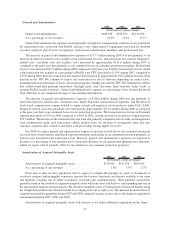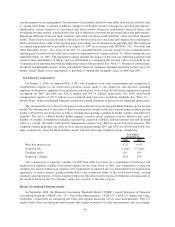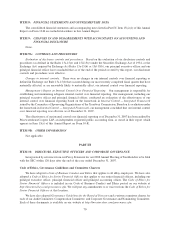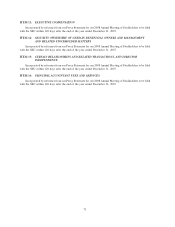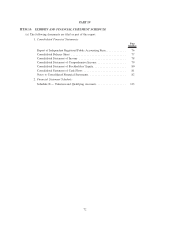eBay 2007 Annual Report Download - page 74
Download and view the complete annual report
Please find page 74 of the 2007 eBay annual report below. You can navigate through the pages in the report by either clicking on the pages listed below, or by using the keyword search tool below to find specific information within the annual report.
Legal Contingencies
In connection with certain pending litigation and other claims, we have estimated the range of probable loss
and provided for such losses through charges to our consolidated statement of income. These estimates have been
based on our assessment of the facts and circumstances at each balance sheet date and are subject to change based
upon new information and future events.
From time to time, we are involved in disputes that arise in the ordinary course of business, and we do not
expect this trend to change in the future. We are currently involved in certain legal proceedings as discussed in
“Item 3: Legal Proceedings” and “Note 8 — Commitments and Contingencies — Litigation and Other Legal
Matters” to our consolidated financial statements included elsewhere in this Annual Report on Form 10-K. We
believe that we have meritorious defenses to the claims against us, and we intend to defend ourselves vigorously.
However, even if successful, our defense against certain actions will be costly and could divert our management’s
time. If the plaintiffs were to prevail on certain claims, we might be forced to pay significant damages and licensing
fees, modify our business practices or even be prohibited from conducting a significant part of our business. Any
such results could materially harm our business and could result in a material adverse impact on the financial
position, results of operations or cash flows of all or any of our three businesses.
Accounting for Income Taxes
We are required to recognize a provision for income taxes based upon the taxable income and temporary
differences for each of the tax jurisdictions in which we operate. This process requires a calculation of taxes payable
under currently enacted tax laws around the world and an analysis of temporary differences between the book and
tax bases of our assets and liabilities, including various accruals, allowances, depreciation and amortization. The tax
effect of these temporary differences are reported as deferred tax assets and liabilities in our consolidated balance
sheet. We also assess the likelihood that our net deferred tax assets will be realized from future taxable income. To
the extent we believe that it is more likely than not that some portion or all of the deferred tax asset will not be
realized, we establish a valuation allowance. At December 31, 2007, we had a valuation allowance on certain
foreign net operating losses based on our assessment that it is more likely than not that the deferred tax asset will not
be realized. To the extent we establish a valuation allowance or change the allowance in a period, we reflect the
change with a corresponding increase or decrease in our tax provision in our consolidated statement of income or
against additional paid-in-capital in our consolidated balance sheet to the extent any tax benefits would have
otherwise been allocated to equity.
Our U.S. businesses generate sufficient cash flow to fully fund their operating requirements, and we expect that
profits earned outside the U.S. will be fully utilized to fund our continued international expansion. Accordingly, we
have not provided for U.S. federal income and foreign withholding taxes on non-U.S. subsidiaries’ undistributed
earnings as of December 31, 2007, because such earnings are intended to be reinvested indefinitely. In the event that
our future international expansion plans change and such amounts are not reinvested indefinitely, we would be
subject to U.S. income taxes partially offset by foreign tax credits.
The following table illustrates the effective tax rates for 2005, 2006, and 2007 (in thousands, except
percentages):
2005 2006 2007
Year Ended December 31,
Provision for income taxes ............................ $467,285 $421,418 $402,600
As a% of income before income taxes ................... 30% 27% 54%
Historically, these provisions have adequately provided for our actual income tax liabilities. Our future
effective tax rates could be adversely affected by earnings being lower than anticipated in countries where we have
lower statutory rates and higher than anticipated in countries where we have higher statutory rates, by changes in the
valuations of our deferred tax assets or liabilities, or by changes or interpretations in tax laws, regulations or
accounting principles. In addition, we are subject to the continuous examination of our income tax returns by the
Internal Revenue Service and other tax authorities. We regularly assess the likelihood of adverse outcomes resulting
from these examinations to determine the adequacy of our provision for income taxes.
64





